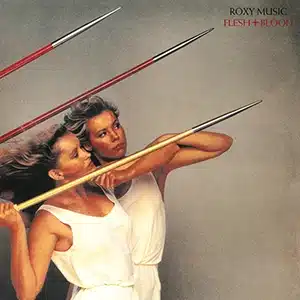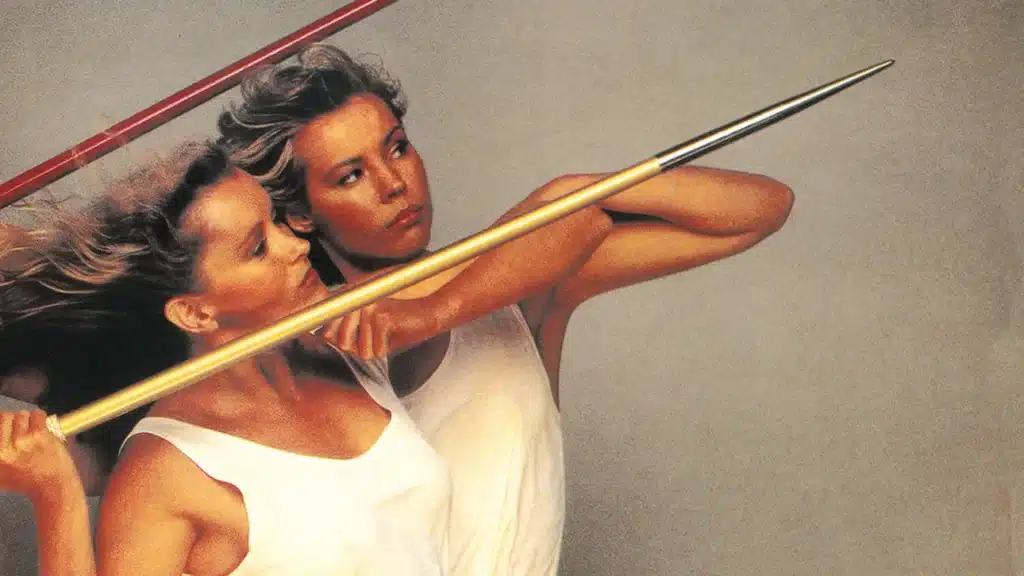
While their penultimate studio album never garnered significant acclaim, Roxy Music’s Flesh + Blood is a moody, influential gem and vastly underrated.
 Flesh + Blood Roxy Music E.G. / Atco-Reprise 23 May 1980
Flesh + Blood Roxy Music E.G. / Atco-Reprise 23 May 1980
Roxy Music are, perhaps by design, a nearly impossible group to categorize. Bursting onto the scene in 1972 with their self-titled debut album, they blended progressive rock, glam, elements of soul, experimental tone poems, and romantic pop, creating a fascinating hybrid that drew influences from David Bowie, King Crimson, and the Velvet Underground. “Psychedelic Sinatra”, according to Simon Le Bon, who inducted them into the Rock and Roll Hall of Fame in 2019, alongside Duran Duran bandmate John Taylor.
Led by the impeccably suave singer-songwriter Bryan Ferry, they churned out eight studio albums in ten years, influencing countless artists and gradually progressing from glam oddballs, in part due to the presence of keyboard wizard Brian Eno on their first two albums, to sophisticated, often radio-friendly pop/rock darlings. As a result of this arc, their later work is intermittently dismissed as less important, but the seventh of their eight studio albums, Flesh + Blood, is more deeply textured and influential than the then-tepid reviews may lead you to believe.

In reassessing Flesh + Blood, which turned 45 this May, it’s essential to place it in the context of Roxy Music as well as the state of pop and rock music at the time of its release. The bloating of progressive rock necessitated the birth of punk, leading to new wave and eventually, the 1981 launch of MTV, which—like it or not—placed a fashion-forward emphasis on popular music like never before. Roxy Music never seemed to shy away from fashion cues, and their music eventually embraced more overt dance-pop gestures with their 1979 album, Manifesto (released after a three-and-a-half-year hiatus, during which Ferry continued his successful solo career).
Building on that momentum, Flesh + Blood can be seen as a refinement—and arguably a progression—of that aesthetic. Experimental concepts established on earlier albums, such as For Your Pleasure and Stranded, were largely abandoned in favor of singles that were more accessible but possessed too much elegance to be dismissed as disposable pop.
This gradual transition likely stemmed from the success of Ferry’s impressive solo output. By the time Flesh + Blood was released, Ferry was already five albums deep into his solo career, with albums ranging from an unusual and highly entertaining covers collection (These Foolish Things) to a record that combined covers with curious reworkings of Roxy Music songs (Let’s Stick Together) to a more stripped-down rock approach of new, all-original material (In Your Mind). Roxy Music’s later studio period seemed to reflect what Ferry was doing on his own.
However, more importantly, Flesh + Blood can be seen as a blueprint for a genre that was to follow in the ensuing decade: the lush sounds of sophisti-pop, a stylish hybrid that incorporated polished arrangements, tasteful synths, undertones of soul and jazz, and lyrics that veer between mystery and romanticism. Artists as varied as Japan, the Style Council, Simple Minds, China Crisis, the Blue Nile, and, yes, Duran Duran, all seemed to draw inspiration from Roxy Music, going back to their earlier Eno era, but more specifically to the stylistic juncture of the late 1970s and early 1980s.
Anyone expecting the vibes of “In Every Dream Home a Heartache”, Roxy Music’s creepy, spoken-word ode to a blow-up doll from 1973’s For Your Pleasure, will be initially disappointed, although their more mainstream approach bears a great deal of creative fruit. The band, now reduced to the core trio of Ferry on vocals and keyboards, oboist/saxophonist Andy Mackay, and guitarist Phil Manzanera (with the aid of a slew of additional side musicians), eke out a great deal of mystery and edge within those dance/pop grooves.
The Covers
Flesh + Blood kicks off with the first of two covers, an obvious nod to Ferry’s covers-heavy solo records, as well as his love for a variety of musical styles that may not seem evident to Roxy Music fans. Covering Wilson Pickett‘s “In the Midnight Hour” is an interesting move, but not all that surprising to anyone who’s heard These Foolish Things, or is aware of Ferry’s love of American soul music (he didn’t name his first son Otis because he was an elevator enthusiast). Nobody in their right mind would confuse Ferry’s croon with the soul shouts of Pickett, but this cover is wisely altered to reflect Roxy’s romantic pop sheen. Like the best covers, it transcends rather than imitates.
Later, on side two, the Byrds‘ psychedelic classic “Eight Miles High” is covered. Again, it’s far from a carbon copy, with the rhythm section of Allan Schwartzberg on drums and Neil Jason providing a throbbing groove alongside the guitar work of Manzanera and Neil Hubbard. Ferry and company have retrofitted their love of subversive 1960s pop to suit their own template, and, in a weird way, it works.
The Singles
In addition to “In the Midnight Hour”, three more singles were released from Flesh + Blood. “Oh Yeah” is a shimmering ballad that combines the power of music with the beauty of romance and the magic of summer. “There’s a band playing on the radio,” Ferry sings, “With a rhythm of rhyming guitars.” Later, the heartbreak rears its head: “There’s a band playing on the radio / And it’s drowning the sound of my tears.”
Meanwhile, “Same Old Scene” revisits the more dance-oriented sounds of Manifesto, with synthesizers and a Roland drum machine propelling the tale of what seems like a middle-aged playboy continuing to sample the party life with typically bored Ferry ennui, perhaps a sequel to “Love Is the Drug”, from 1975’s Siren? While the words may or may not be autobiographical—Ferry thrives on ambiguity in his lyrics—the song’s contemporary swagger almost seems like an instruction manual on How to Build a Duran Duran.
“Over You” may be less influential and more influenced. After all, it effectively cribs the bassline from the Cars‘ “My Best Friend’s Girl”, resulting in a catchy, sunny summer single that reached the Top Five in the UK, but, like most of Roxy Music’s singles, failed to chart in the US.
The Deep Cuts
The lesser-known songs on Flesh + Blood are something of a mixed bag, but still worthwhile. The title track brings back the menace of the early days, thanks to its simple, slashing guitar riff and dramatic synths, both played by Bryan Ferry. The song simmers and threatens but never directly attacks the listener, creating an effect that would influence the sound of bands like Japan.
The same approach is taken with the angular melodies and keyboard attacks of “Rain, Rain, Rain”, not to mention Alan Spenner’s gurgling bass lines. They are in sharp contrast to the languid, new romantic gestures of “My Only Love” and “No Strange Delight”, songs that are admirable in their execution but probably the least vital tracks on the album.
The final track on Flesh + Blood isn’t a cover. Still, oddly enough, it seems to borrow the overall mood of “Jealous Guy”, the John Lennon song Roxy Music covered in early 1981, released as a single shortly after Lennon’s assassination. Bolstered by Mackay’s sterling saxophone work and gorgeous piano and organ work from Paul Carrack, it ends the album on a wistful, ruminating tone, closing out a record filled with new ideas and building on concepts Roxy Music had been working on for years.
Upon its release, Flesh + Blood was greeted with mixed reviews. While Greil Marcus praised the record – “All graceful lust and wistful regret… like a perfect July day, it makes no demands on a listener, yet it can give a listener everything”, Ken Tucker slammed it in Rolling Stone, writing that “Flesh + Blood is such a shockingly bad Roxy Music record that it provokes a certain fascination.” However, it’s essential to view Flesh + Blood as more of an influencer of what was to come, rather than its role in the overall mood of 1980 or its place within Roxy Music’s discography.
Roxy Music released one more studio album in 1982, the epochal Avalon, which fared far better commercially and critically than its predecessor, due in part to the previous year’s launch of MTV. The videos for the singles “More Than This” and “Avalon” received heavy airplay on the channel, likely introducing a younger generation to their music. It’s also arguably a better album, a dreamy sonic landscape benefiting from strong songwriting and unique arrangements.
To this day, they still tour occasionally. Ferry continues to release often brilliant solo albums; 1985’s Boys & Girls and 1987’s Bete Noire are among his finest works. However, Flesh + Blood, while lacking the alien synth moves and epic-length experimental exercises of their first few albums, is still a strong, vastly underrated record whose nearly subliminal influence has been felt for decades.


